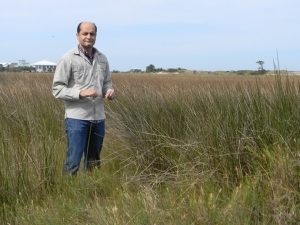Study Estimates Reduced Nitrogen Removal Capacity in Marshes with Vegetation Loss
– DECEMBER 20, 2017
Alabama researchers measured the nitrogen removal capacity of marsh sediments and compared it to sediments from subtidal unvegetated mudflats, which are what the marsh becomes when it erodes.
The scientists found that the average denitrification capacity in sediments from vegetated marsh areas was four-times higher than from subtidal mudflats, likely due to enhanced nitrification and greater availability of organic carbon. The abundance of denitrifiers (microbes genetically capable of removing nitrogen) were similar in both areas, suggesting that marsh vegetation regulates the activity of denitrifying microbes rather than their abundance. The researchers published their findings in Environmental Science & Technology: Vegetation loss decreases salt marsh denitrification capacity: Implications for marsh erosion.
Marshes worldwide and particularly in the Gulf of Mexico region have been disappearing at unprecedented rates. This loss is linked to several factors including rising seas, lack of sediment input (resulting from dams built on rivers, diking, and draining), and agricultural use. Oil spills, such as the Deepwater Horizon incident, are another form of disturbance that negatively affects marshes because oiled grasses can die, which can lead to subsequent erosion.
Marshes provide important ecosystem services such as denitrification, a microbially mediated process that reduces nitrates in soil and releases nitrogen into the air. Environmental disturbances can contribute to losses in salt marsh vegetation, potentially reducing the marsh’s capacity to remove nitrogen. “Too much nitrogen flowing into coastal waters can lead to harmful algal blooms, hypoxia, and fish kills,” explained study author Behzad Mortazavi. “Marshes, which are aesthetically pleasant, act like Mother Nature’s wastewater treatment plant.”
The Chandeleur Islands, a coastal Louisiana island chain, experienced moderate oiling during Deepwater Horizon. Researchers collected sediment core samples there from July 2015 – February 2016 and used isotopes and a membrane inlet mass spectrometer to trace how much nitrogen was permanently removed. The team also analyzed denitrification potential rates and DNA in sediment samples to assess the abundance of denitrification genes.
The team estimated that sediments from vegetated marshes removed an average of 3.6 t N km-2 y-1 compared to 0.9 t N km-2 y-1 from unvegetated subtidal mudflats. “In regions where the spill has caused marshes to erode away, the nitrogen removal capacity has been greatly reduced. This study helps the public appreciate the magnitude of the loss of the capacity to remove nitrogen once a marsh disappears,” said Mortazavi.
Data are publicly available through the Gulf of Mexico Research Initiative Information & Data Cooperative (GRIIDC) at doi:10.7266/N7GX48KH, doi:10.7266/N7C53HWJ, doi:10.7266/N7MK69XZ, doi:10.7266/N79P2ZR9, doi:10.7266/N75X271C, and doi:10.7266/N7154F44.
The study’s authors are Sarra E. Hinshaw, Corianne Tatariw, Nikaela Flournoy, Alice Kleinhuizen, Caitlin Taylor, Patricia A. Sobecky, and Behzad Mortazavi.
************
This research was made possible in part by a grant from the Gulf of Mexico Research Initiative (GoMRI) to the Alabama Center for Ecological Resilience (ACER).
The Gulf of Mexico Research Initiative (GoMRI) is a 10-year independent research program established to study the effect, and the potential associated impact, of hydrocarbon releases on the environment and public health, as well as to develop improved spill mitigation, oil detection, characterization and remediation technologies. An independent and academic 20-member Research Board makes the funding and research direction decisions to ensure the intellectual quality, effectiveness and academic independence of the GoMRI research. All research data, findings and publications will be made publicly available. The program was established through a $500 million financial commitment from BP. For more information, visit https://gulfresearchinitiative.org/.
© Copyright 2010-2017 Gulf of Mexico Research Initiative (GoMRI) – All Rights Reserved. Redistribution is encouraged with acknowledgement to the Gulf of Mexico Research Initiative (GoMRI). Please credit images and/or videos as done in each article. Questions? Contact web-content editor Nilde “Maggie” Dannreuther, Northern Gulf Institute, Mississippi State University (maggied@ngi.msstate.edu).






